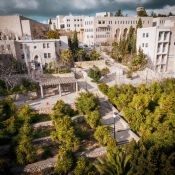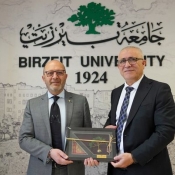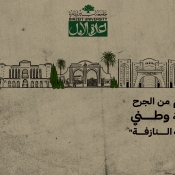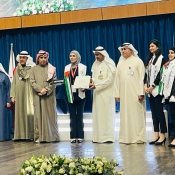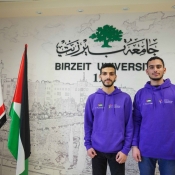Symposium examines state, future of the Palestinian cause
The Ibrahim Abu-Lughod Institute of International Studies at Birzeit University, in cooperation with the Konrad-Adenauer-Stiftung, organized a symposium entitled “Complex Issues of the Palestinian Cause: The Question of Representation, Autonomy, and Future Scenarios,” on December 16, 2017. The symposium was facilitated and commentated by the Professor of Cultural Studies and International Studies Dr. Ghassan Al-Khatib.
Featuring papers by political science professors, the symposium explored the dual nature of Palestinian representation, the legitimacy of the Israeli proposals of establishing self-rule government in Palestine, in addition to envisioning the possible directions, which the Palestinian representation and identity could take.
The Professor of Political Science Dr. Ahmad Azem presented his paper, “Towards an Exit from the Issues of Palestinian Representation Institutes,” which traces the question of democratic representation for Palestinians throughout the history of the Palestinian cause. Specifically, the paper historicizes the Palestinian National Council and contextualizes its sessions during its many years.
Dr. Azem gave a brief abstract of his paper and outlined his recommendations and findings, stating that “the Palestinian question of representation is inherently difficult to contextualize and analyze, mainly because representation for Palestinians was not only a vessel of democracy and a mechanism of voting, but it was also a mechanism for attaining statehood and nationhood.”
“Because there was no legal, officially sanctioned Palestinian state, the Palestinian Liberation Organization (PLO) was itself formed in the structure of one; and the Palestinian National Council (PNC) was the legislative body of this interstitial state.
The PNC served a two-fold role: first, it was a quasi-parliament which provided a democratic place for discussion, and second, it was an entity which included people who engaged in asymmetric warfare to free Palestine. It would convene mostly at times of foreign threats to the Palestinian cause, or at times of great political upheaval,” added Dr. Azem.
Dr. Azem’s paper concluded with recommendations on how to fix the current state of the PNC, which included: convening a public conference in the form of the one held in 1972; returning to the concept of a central committee; reaching a decision on the membership count; and defining the relationship between the Palestinian Authority and the PNC.
The Professor of Political Science and Director of the MA Program in International Studies at Birzeit University Dr. Ali Jarbawi presented his paper which revolved around the validity of Palestinian autonomy, “The two-state solution, or even for a brief period, the one-state solution, was the go-to approach in peace agreements and plans. Israel, however, wants neither one of those solutions; it aims for a hybrid solution in which it has absolute control of Jerusalem, keeps the Palestinian Authority’s self-rule over the West Bank, and possibly allow the creation of an “independent State” in Gaza.”
Autonomy, said Dr. Jarbawi, first emerged at the Camp David Accords and was first agreed on by the Palestinians at the Oslo Accords, “These agreements stipulated the continuity of self-rule until a political resolution is reached.” This means, according to Dr. Jarbawi, that Israeli’s were not committed to the two-state solution.
“Politically speaking, autonomy first came into prominence at the collapse of the Soviet Union and the Eastern Bloc. At that time, there was a need for a new line of thinking to hold the stability of multi-ethnic or multi-racial nation-states. Autonomy is a mechanism by which a racial, ethnic, or a political minority is granted the leeway to exercise its full rights without intervention from any outside authorities. In other words, autonomy recognizes the sovereignty and independence of a minority within a nation-state.”
“This system,” concluded Dr. Jarbawi, “can only be fully applicable within a democratic government and for a minority of its citizens. Israel is not in any way, shape, or form a democratic government; Palestinians are not minority-citizens of Israel, and the West Bank is not part of Israel so that it could exercise autonomy or self-rule over it.”
After Dr. Jarbawi concluded his presentation, the Director of Ibrahim Abu-Lughod Institute of International Studies Dr. Lourdes Habash presented her paper, entitled “Scenarios of the Palestinian Cause,” which revolves around the main question: Would there ever be a Palestinian state? How would it come to fruition?
Dr. Habash first explained the process of scenario building, “It is a strategic, methodological procedure that involves an analysis of the variables, historical trends, and events followed by the extrapolation of those result into the future. The frameworks I’ve chosen for my study are the realist and liberal theories as well as the theory of revolution – to account for unexpected geopolitical shifts in power.”
“The first scenario, the Force Scenario, builds on the realist theory. The scenario revolves around the concept of maintaining the status quo, or the status quo+, which would lead to unilateral action by Israel, and a continuation of the settlement and aggressive policies that it has been pursuing. This scenario is governed by these following variables: continuation of peace negotiations; maintaining security cooperation; preservation of the flow of international aid; and following neo-liberal policies.”
“As for the Arab World, the variables are: continuation of the war in Syria, Yemen, and Iraq, and a general state of disarray. These variables, if followed through, shine the light away from the Palestinian cause, thereby allowing Israel to continue its violations and aggressive policies without much intervention from the outside world.”
“Another scenario,” continued Dr. Habash, “is the Agreement Scenario, which would entail a Palestinian state that is part of a confederacy with Jordan.”
A discussion of the three papers followed the last presentation, with members of the attending audience reviewing and analyzing the hypotheses, line-of-thinking, and findings of the presentations.

